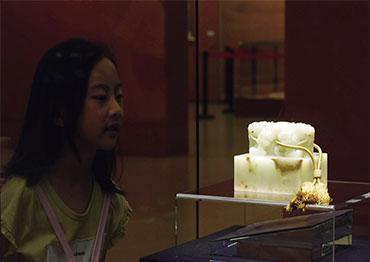The British Museum and the Palace Museum are the world’s largest museums by different standards. The British Museum’s collection holds over 8 million objects, more than any other museum in the world. The Palace Museum is built on an area of 1.12 million square meters, larger than any other museum in the world.
Early collections at the two museums mainly came from private collectors. Sir Hans Sloane, an Anglo-Irish physician, donated his collection of 71,000 items to his country when he died in 1753, on the condition that 20,000 pounds would be paid to his heirs and a free public museum be built. The British Museum opened to the public six years later in 1759.
At that time, the Palace Museum, also known as the Forbidden City, was the residence of the emperors of the Qing Dynasty (1644- 1911). It was the 24th year of the rule of Emperor Qianlong of the Qing, China’s last imperial dynasty. He would remain on the throne for another 36 years.
TV series about Qianlong’s life have been popular in China in recent decades, where he is portrayed as a ruler who enjoyed poetry and travel. It is true that he was fond of literature and the arts, and collected a lot of curios, calligraphy and paintings. He archived all his collections, stamping his favorite calligraphy works and paintings with various seals. For example, one of his seals read “Sanxi Tang,” which was the name of his study. Another seal bore the inscription “Father of the Emperor,” as he later abdicated the throne to his son.
His obsession with collecting antiques and putting his seal on the ancient calligraphy and paintings in his collection might have been inspired by another enthusiastic collector. Nearly half of the Qing’s imperial collection of calligraphy and paintings came from Xiang Yuanbian, a wealthy man born in 1525 during the Ming Dynasty (1368-1644).
The scion of an extremely rich family, Xiang had no need or desire to work hard. He refused an official position offered by Ming Emperor Wanli. His only interest was collecting antiquities, calligraphy and paintings. He was rich enough that he bought up nearly all the precious antiquities that could be found in the most prosperous areas of eastern China, particularly in what are today’s Jiangsu and Zhejiang provinces. One of his favorites was a seven-stringed plucked instrument with the inscription “heavenly voice” which was probably made during or before the 3rd century. Xiang loved it so much that he built a special museum, called the Tower of Heavenly Voice in Jiaxing, Zhejiang Province to house the instrument and other precious antiques. The instrument now resides in the Palace Museum.
Xiang spent all day in the tower appreciating his collection, or putting his seals on the calligraphy and paintings he valued the most. He once stamped 98 seals on one calligraphy piece. By the time Emperor Qianlong acquired it, there was no space left in the margins for him to stamp his own seals. So he stamped over the calligraphy.
Xiang devised a special way to catalogue his collections. He wrote one character from the Thousand-Character Classic, a text used for children’s early education, on each calligraphy piece or painting he collected. Based on this system, Weng Tongwen, a prestigious Chinese historian who died in 1999, estimated that Xiang owned 2,190 calligraphy works and paintings.
When Xiang died in 1590, the Ming Dynasty was already on the decline. It finally fell after a peasant-led rebellion and attacks from the Manchu army. Xiang’s descendants fled. The Tower of Heavenly Voice was destroyed in the chaos, and most of its precious collections were acquired by the Qing court. In total, the recorded imperial collection of ancient calligraphy and paintings amounted to 4,600 pieces. Xiang’s collection made up nearly half of the Qing’s royal collection of ancient calligraphy and paintings.

 Old Version
Old Version


